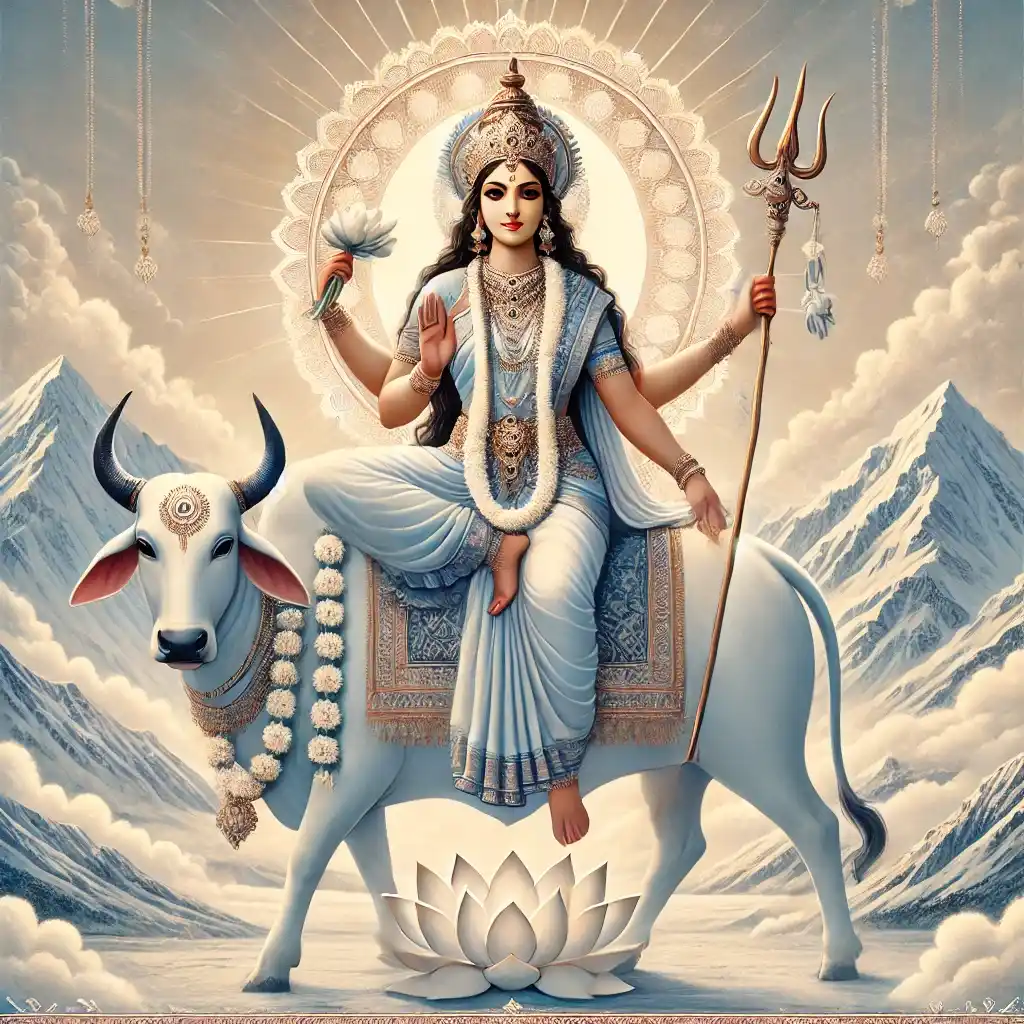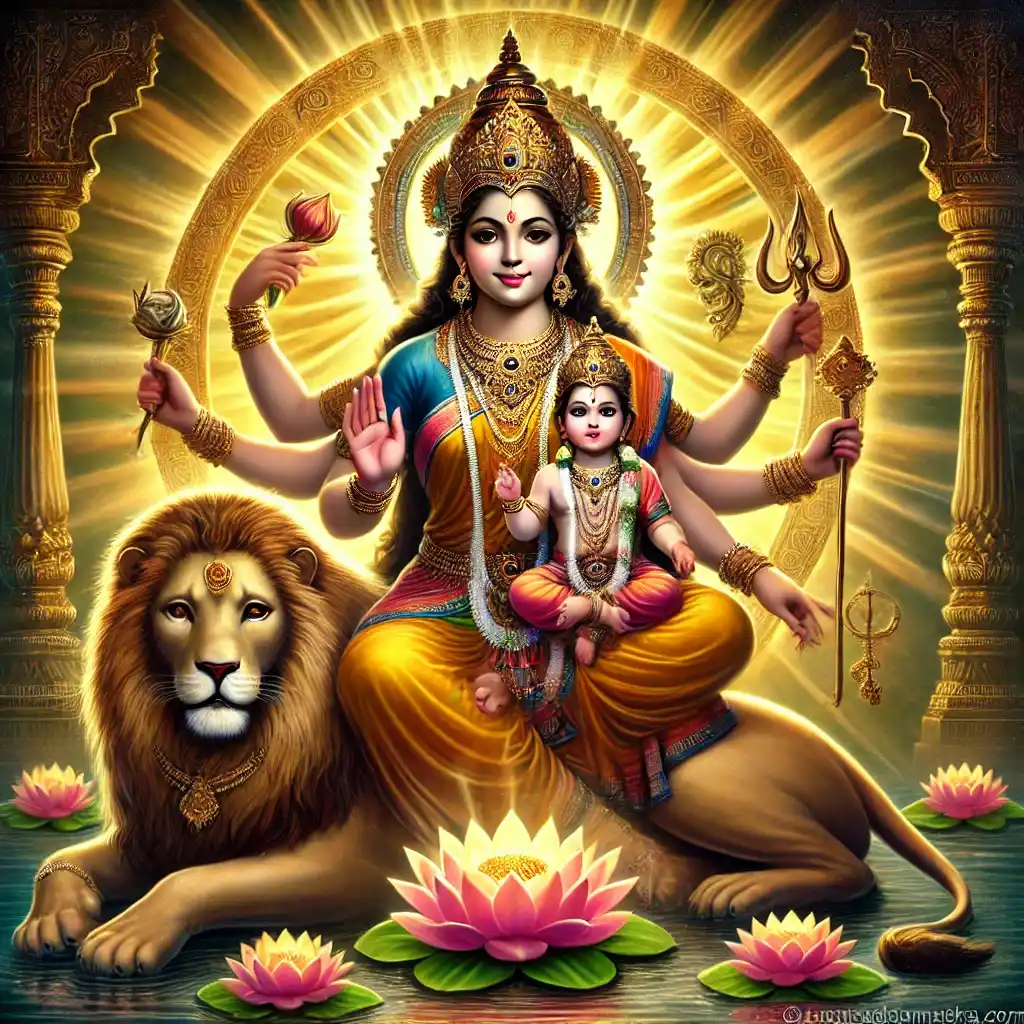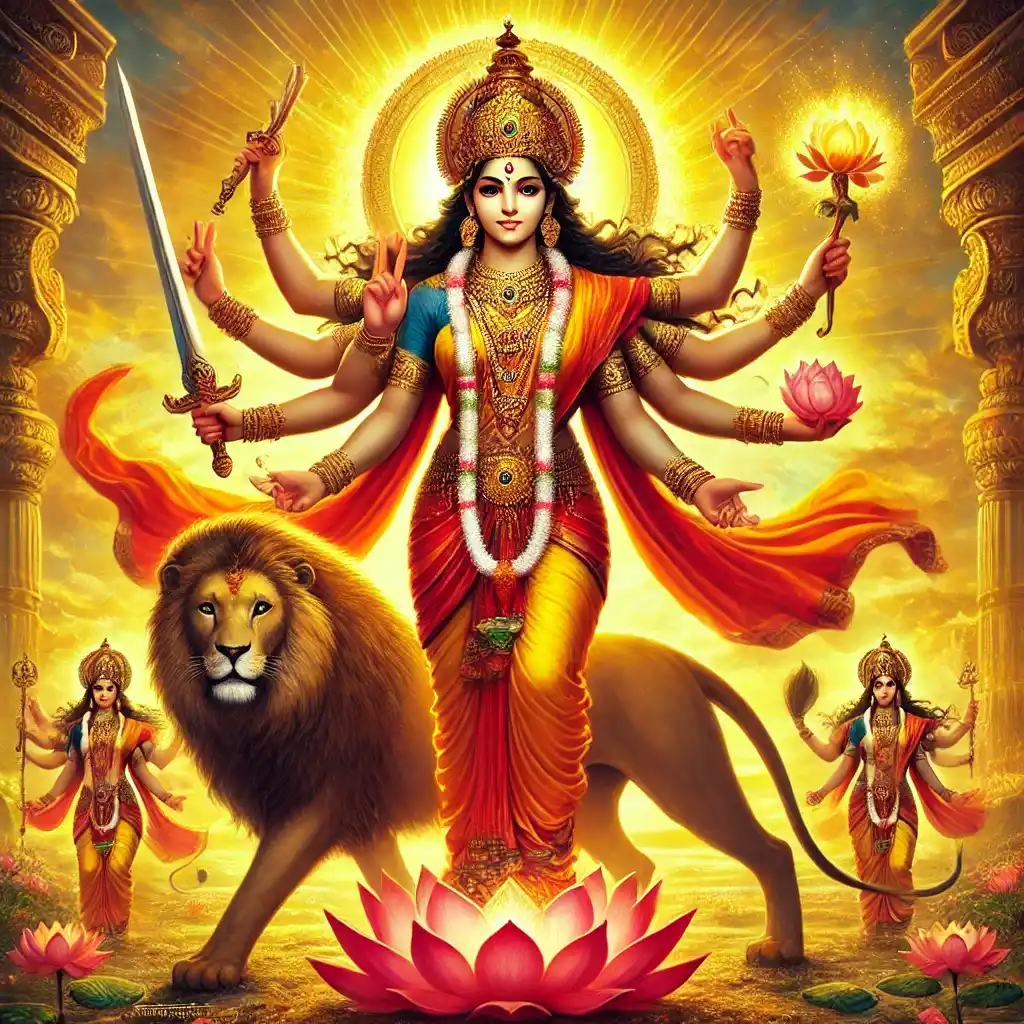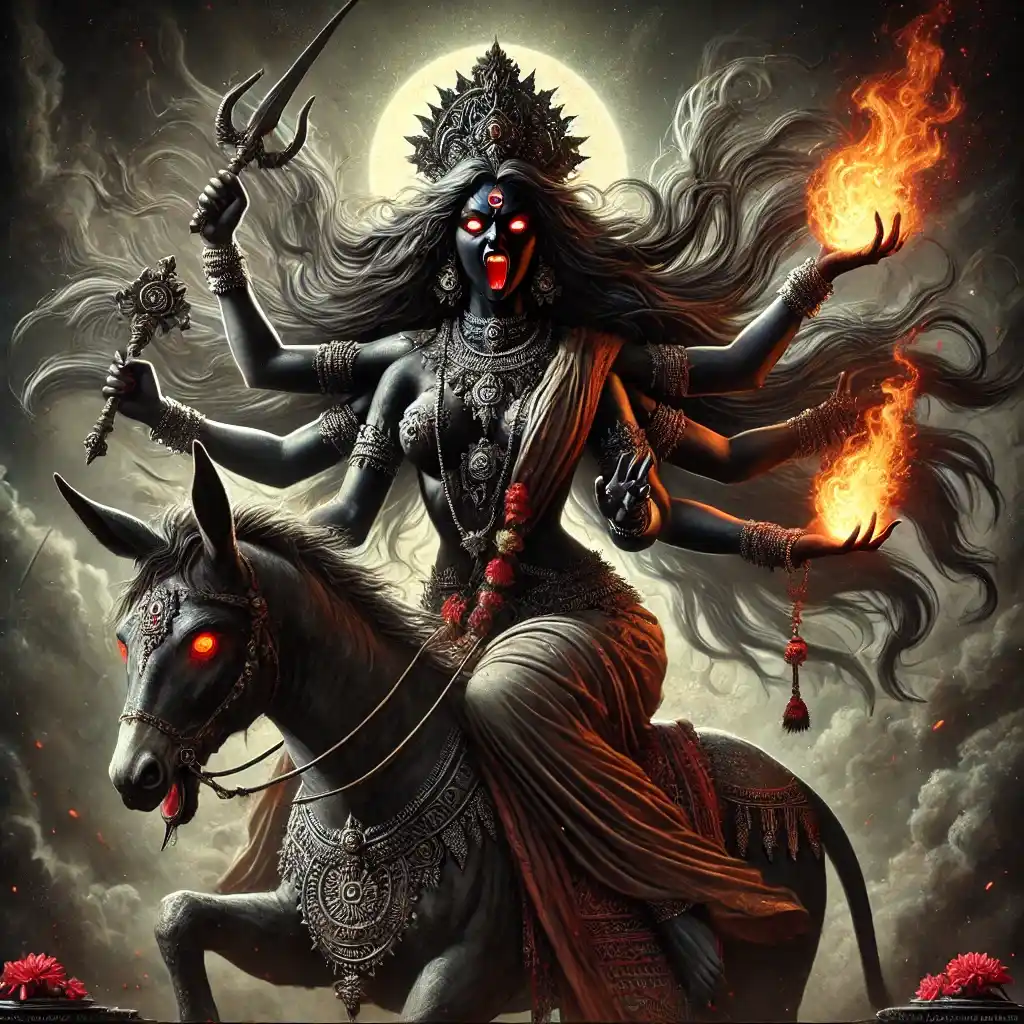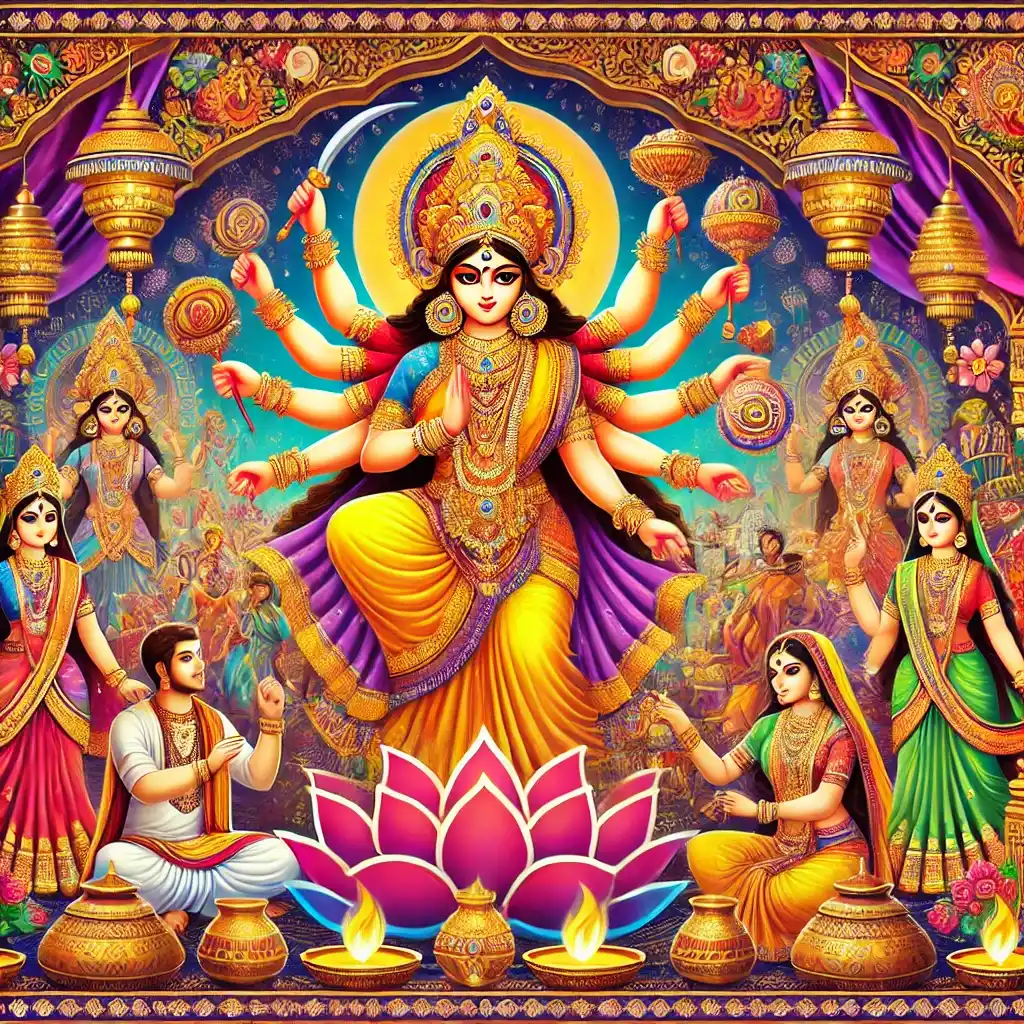
Navaratri
Navaratri
Celebrating the Nine Divine Nights of Devi
Navaratri is one of the most widely celebrated and revered festivals in India, observed with great enthusiasm, devotion, and festivity. Literally translating to "nine nights" in Sanskrit, Navaratri is dedicated to the worship of Goddess Durga and her nine divine forms. This festival is celebrated over a span of nine nights and ten days, culminating in Dussehra, symbolizing the triumph of good over evil. Navaratri is not only a time for religious observance but also an acknowledgment of the feminine divine power, or "Shakti," which is believed to be the core energy that governs the universe.
While the central theme of Navaratri remains the worship of Goddess Durga, the festival has various cultural, social, and spiritual layers, making it one of the most significant celebrations in the Hindu calendar. Whether it’s through fasting, rituals, dance, or music, Navaratri is a time for personal introspection, devotion, and community bonding.
Significance of Navaratri
The significance of Navaratri transcends mere religious rituals, encapsulating deeper philosophical and spiritual meanings. It is celebrated to honor the triumph of light over darkness, knowledge over ignorance, and, most importantly, the victory of good over evil forces. Goddess Durga, the principal deity worshipped during Navaratri, embodies divine energy and strength, referred to as Shakti. She represents the universal mother and protector, who destroys evil and restores righteousness, or "dharma."
According to Hindu mythology, Navaratri commemorates the battle between Goddess Durga and the buffalo demon, Mahishasura. Mahishasura was a powerful demon who had acquired a boon that made him invincible against any man or god. Drunk on his newfound power, Mahishasura wreaked havoc across the heavens and earth. In response, the divine feminine power was invoked, and Goddess Durga was created. After a fierce battle that lasted nine days, she vanquished Mahishasura, symbolizing the destruction of evil and the restoration of peace and harmony.
The myth of Mahishasura’s defeat has several interpretations. On a spiritual level, it is seen as the destruction of the ego and negativity within each individual, with Goddess Durga representing the inner strength needed to overcome personal obstacles. On a social and cultural level, the festival of Navaratri encourages the empowerment of women, celebrating the feminine force as a powerful and nurturing entity. In this sense, Navaratri is a reminder of the vital role of balance between the masculine and feminine energies in the universe.
Regional Variations in Significance
Navaratri is celebrated differently across various regions in India, and each region has its own interpretation of the festival's significance:
In North India, the festival is closely linked with the Ramayana, and the celebration marks Lord Rama's victory over the demon king Ravana. The tenth day of Navaratri, called Dussehra or Vijayadashami, commemorates the killing of Ravana, symbolizing the triumph of virtue over vice. In cities like Delhi, large effigies of Ravana, along with his brothers Meghnath and Kumbhakarna, are set ablaze, serving as a visual representation of good overpowering evil.
In Gujarat, Navaratri takes on a more social and cultural role. It is synonymous with Garba and Dandiya Raas, traditional folk dances performed in honor of the goddess. For nine nights, people dressed in vibrant and colorful attire gather to dance, sing, and celebrate. These dances are performed in a circle, symbolizing the cyclic nature of life and the universe. The energy and enthusiasm during these nights highlight the social significance of Navaratri as a festival that fosters community bonding.
In West Bengal, Navaratri coincides with the grand festival of Durga Puja. Here, the last five days of Navaratri are devoted to the worship of Goddess Durga in her most splendid form. Beautifully decorated idols of Durga slaying Mahishasura are placed in elaborately designed "pandals" or temporary structures. Devotees come together to offer prayers, sing devotional songs, and participate in cultural activities. Durga Puja in Bengal is not just a religious event; it is a socio-cultural phenomenon that involves art, music, dance, and literature, with the streets teeming with life and vibrancy.
The Nine Forms of Goddess Durga
Each day of Navaratri is dedicated to one of the nine forms of Goddess Durga, collectively known as Navadurga. These nine manifestations represent different aspects of feminine divinity, ranging from innocence and purity to ferocity and wisdom. Worshipping these forms sequentially is believed to bring blessings, protection, and spiritual enlightenment.
Day 1 – Shailaputri: The Daughter of the Mountains: On the first day, devotees worship Shailaputri, which means "daughter of the mountains." She is the embodiment of nature itself and is revered as the consort of Lord Shiva. Shailaputri is depicted riding a bull (Nandi), holding a trident in one hand and a lotus in the other. This form of the goddess is often associated with the Muladhara chakra, or root energy, symbolizing the foundation of all material existence. Shailaputri is worshipped for physical and mental strength, and her blessings ensure a strong beginning to the spiritual journey of Navaratri.
Day 2 – Brahmacharini: The Goddess of Penance and Devotion: The second day is dedicated to Brahmacharini, the goddess who represents penance, devotion, and austerity. This form signifies the deep commitment and determination required on the spiritual path. Brahmacharini is depicted walking barefoot with a rudraksha mala (rosary) in one hand and a kamandal (water pot) in the other. Her blessings are sought for wisdom, determination, and success in endeavors that require hard work and dedication.
Day 3 – Chandraghanta: The Fierce Warrior: On the third day, Chandraghanta, the warrior goddess, is worshipped. She is known for her courage and valor in battle, often depicted with a crescent moon on her forehead, hence the name Chandraghanta (Chandra meaning "moon" and Ghanta meaning "bell"). Chandraghanta is known to radiate peace and serenity while also being ready to battle evil forces. She rides a lion and is worshipped for courage and to overcome fears, making her an essential figure in the Navaratri celebrations.
Day 4 – Kushmanda: The Creator of the Universe: On the fourth day of Navaratri, devotees offer prayers to Kushmanda, who is believed to be the creator of the universe. According to legend, she brought light into the void with her divine smile. She is depicted with eight arms holding different weapons, a lotus, and a kamandal. Kushmanda’s name literally means "little cosmic egg," symbolizing the birth of the universe from a tiny seed. Devotees believe that worshipping her brings health, prosperity, and well-being, as she is also associated with the heart chakra, the seat of unconditional love.
Day 5 – Skandamata: The Nurturing Mother: The fifth day is dedicated to Skandamata, the mother of Lord Skanda (Kartikeya), the god of war. Depicted holding her son in her lap, Skandamata symbolizes maternal love, protection, and nurturing. She rides a lion and is often portrayed with four arms, holding lotus flowers and the infant Kartikeya. Skandamata’s blessings are sought for the well-being and protection of one’s children and family. Worshipping her also brings prosperity, as she is believed to protect devotees from harm and misfortune.
Day 6 – Katyayani: The Warrior Goddess: Katyayani, the sixth form of Goddess Durga, is worshipped for her fierce and warrior-like demeanor. She is associated with the color red, symbolizing bravery and strength. According to legend, she was born from the anger of the gods to vanquish the demon Mahishasura. Young unmarried women worship Katyayani to seek her blessings for a good husband and a happy married life. In some parts of India, women also invoke her during Navaratri to gain strength and resolve, making Katyayani a significant figure in the spiritual and cultural landscape of the festival.
Day 7 – Kalaratri: The Fierce Protector: On the seventh day, devotees worship Kalaratri, the most fearsome and destructive form of Durga. She is depicted with a dark complexion, disheveled hair, and a necklace of lightning, symbolizing her fierce, protective nature. Her three eyes radiate fierce energy, and she rides a donkey. Kalaratri is known for destroying ignorance and protecting her devotees from evil spirits and negative energies. Despite her fierce appearance, she bestows blessings of peace and calm on those who seek her protection.
Day 8 – Mahagauri: The Goddess of Purity: On the eighth day of Navaratri, devotees offer prayers to Mahagauri, the symbol of purity and serenity. Mahagauri, meaning "extremely white," is known for her radiant complexion and is often depicted riding a white bull. She is associated with the power to absolve past sins and grant peace and tranquility to her devotees. Worshipping Mahagauri is believed to purify the soul, bring wisdom, and foster spiritual growth. Her blessings are sought for inner peace and spiritual enlightenment.
Day 9 – Siddhidatri: The Giver of Supernatural Powers: The ninth and final day of Navaratri is dedicated to Goddess Siddhidatri, the ultimate form of Durga who grants divine wisdom and supernatural powers (siddhis). The name Siddhidatri translates to "the one who grants siddhis," and she is revered as the goddess who fulfills the spiritual aspirations of her devotees, helping them attain perfection in their endeavors, both worldly and spiritual.
Navaratri and the Nine Colors: A Symbol of the Goddess’s Power
One of the unique aspects of Navaratri is the tradition of wearing a different color each day, with each color representing one of the forms of Goddess Durga. These colors not only add a vibrant element to the celebrations but also symbolize the different qualities and powers of the goddess.
Day 1: Yellow (Shailaputri) – The first day is associated with the color yellow, symbolizing brightness and happiness. Yellow represents the nurturing and grounding aspect of Shailaputri, the daughter of the mountains. Devotees wear this color to invoke stability and positivity in their lives.
Day 2: Green (Brahmacharini) – Green is the color for the second day, symbolizing growth, serenity, and peace. Brahmacharini, the goddess of penance and devotion, represents a calm and focused mind, and the green color is said to bring about these qualities.
Day 3: Grey (Chandraghanta) – Grey, symbolizing balance and neutrality, is worn on the third day. Chandraghanta, the fierce form of Durga with a crescent moon on her forehead, embodies strength and tranquility. This color encourages devotees to find balance between calmness and action.
Day 4: Orange (Kushmanda) – The fourth day is marked by the vibrant color orange, symbolizing energy, enthusiasm, and creativity. Goddess Kushmanda is associated with the cosmic egg and the creation of the universe, and the orange color represents her fiery energy and the vitality she brings into the world.
Day 5: White (Skandamata) – White, representing purity, peace, and wisdom, is worn on the fifth day. Skandamata, the mother of Skanda (Kartikeya), symbolizes the motherly affection of the goddess, and the white color reflects the nurturing and protective aspects of this form of Durga.
Day 6: Red (Katyayani) – The sixth day is associated with red, a color that symbolizes power, passion, and strength. Goddess Katyayani, a fierce and warrior-like form of Durga, is revered for her ability to vanquish evil forces. Red reflects her courage and fierce energy.
Day 7: Royal Blue (Kalaratri) – On the seventh day, devotees wear royal blue, which symbolizes immense power and divine energy. Kalaratri, the goddess who destroys darkness and removes ignorance, is invoked through this color. Royal blue reflects the limitless power of the goddess and her role in dispelling fear.
Day 8: Pink (Mahagauri) – Pink, a color symbolizing compassion, love, and beauty, is worn on the eighth day. Mahagauri, the radiant and pure form of Durga, is worshipped for her ability to provide peace and tranquility. The pink color signifies purity of thought and action.
Day 9: Purple (Siddhidatri) – The ninth day is associated with the color purple, symbolizing ambition, prosperity, and power. Siddhidatri, the goddess who grants wisdom and supernatural abilities, represents the culmination of spiritual growth. The purple color reflects the profound transformation and enlightenment achieved by devotees during Navaratri.
Cultural Significance of Fasting During Navaratri
Fasting is a major aspect of Navaratri and holds profound spiritual, cultural, and health significance. In many Indian households, fasting is seen as an essential practice to cleanse both body and mind, helping devotees achieve a state of inner purity and focus.
Spiritual Significance of Fasting: From a spiritual perspective, fasting is believed to purify the soul and strengthen the connection between the devotee and the goddess. By abstaining from certain foods and focusing on prayer and meditation, devotees cultivate discipline and self-restraint. Fasting is seen as a means to remove distractions and focus on spiritual growth. Many devotees believe that by controlling one’s physical cravings, they can also learn to control the mind and emotions, which helps in overcoming negative tendencies and thoughts.
Cultural and Health Aspects of Fasting: In addition to its spiritual importance, fasting during Navaratri has cultural and health benefits. The foods typically consumed during Navaratri are part of a sattvic (pure) diet, which includes fruits, dairy, and simple grains like kuttu (buckwheat), rajgira (amaranth), and singhara (water chestnut). This diet is light, easy to digest, and provides the body with essential nutrients while giving the digestive system a break from heavier foods like meat, grains, and processed items. This temporary shift to a lighter diet helps in detoxifying the body and rejuvenating the system.
The Environmental Aspect of Navaratri Celebrations
In recent years, there has been an increasing awareness about the environmental impact of large-scale Navaratri celebrations, particularly in relation to the immersion of idols and the use of non-biodegradable materials in festival decorations.
Eco-Friendly Idols and Sustainable Celebrations
Traditionally, idols of Goddess Durga and other deities were made from natural clay and other biodegradable materials. However, with the commercialization of festivals, many idols are now crafted using Plaster of Paris (POP) and painted with chemical-based colors, which cause pollution when the idols are immersed in water bodies at the end of the festival. POP idols do not dissolve easily, leading to water pollution, harming aquatic life, and clogging water systems.
In response to these environmental concerns, many communities and organizers have started promoting the use of eco-friendly idols made from natural clay and painted with organic colors. These idols dissolve easily in water, reducing pollution and minimizing harm to the environment. Additionally, there has been a push for more sustainable practices, such as using biodegradable materials for pandals, reducing the use of plastic decorations, and organizing community immersions to limit the number of idols immersed in rivers and lakes.
Community-Led Clean-Up Drives
Another positive trend is the emergence of community-led clean-up drives after the festivities. Volunteers, often led by environmental groups and local organizations, gather to clean up the debris left behind after the idol immersions. These initiatives not only help in maintaining the cleanliness of water bodies but also raise awareness about the importance of preserving the environment during religious celebrations.
Navaratri in the Modern Context: A Global Festival
While Navaratri has its roots in Indian culture, its appeal has transcended national boundaries, making it a global celebration. Indian communities around the world, especially in countries like the United States, Canada, the United Kingdom, and Australia, celebrate Navaratri with the same enthusiasm and reverence as it is in India.
Navaratri Celebrations in the Indian Diaspora: In cities with significant Indian populations, such as New York, London, and Sydney, Navaratri is celebrated in community centers and temples. Cultural organizations often host large-scale Garba and Dandiya nights, attracting not only Indian expatriates but also people from other communities who enjoy participating in the colorful festivities. These events offer a way for the Indian diaspora to stay connected with their cultural roots and pass on traditions to the younger generation.
Fusion of Traditional and Modern Elements: In many places, Navaratri celebrations have taken on a more contemporary flavor, blending traditional customs with modern elements. For instance, while Garba and Dandiya remain the central focus, many events now feature live performances by popular artists, fusion music, and modern dance forms that appeal to the younger crowd. Even the traditional attire has evolved, with participants incorporating modern fashion trends into their costumes while retaining the essence of the festival.
Final Reflections: Navaratri’s Timeless Message
Navaratri is a festival that beautifully encapsulates the essence of devotion, community, and the triumph of good over evil. Through its rituals, fasting, and celebrations, Navaratri offers an opportunity for spiritual renewal, self-reflection, and the cultivation of inner strength. The nine forms of Goddess Durga remind devotees of the various facets of life—protection, courage, wisdom, and compassion—that are necessary to lead a balanced and fulfilling life.
In a world that is constantly evolving, the relevance of Navaratri remains as strong as ever. Whether through traditional rituals or modern adaptations, the festival continues to inspire millions to celebrate the divine feminine, strive for inner harmony, and uphold the values of truth, justice, and righteousness.
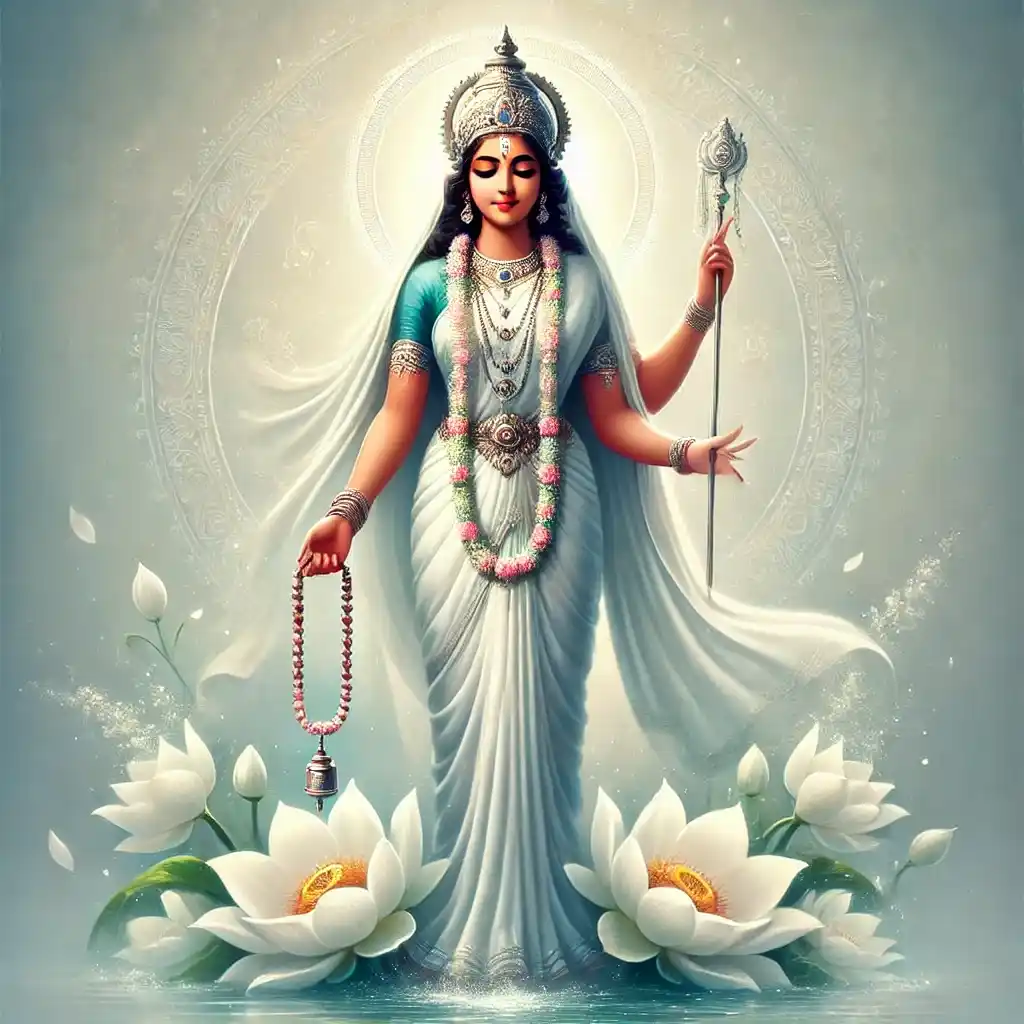
Discover the story of Goddess Brahmacharini, the embodiment of devotion, penance, and inner strength. Learn about her significance in Hindu mythology, how she is worshipped during Navaratri, and the timeless spiritual lessons she offers for modern life. Explore her symbolism and how she empowers spiritual seekers through perseverance and self-discipline.

Discover the legend, symbolism, and spiritual significance of Maa Chandraghanta, the fierce yet compassionate third form of Goddess Durga. Learn about her role in Navaratri, rituals, blessings, and how worshiping her brings courage, protection, and inner peace. Uncover the essence of the warrior goddess who embodies strength and serenity.
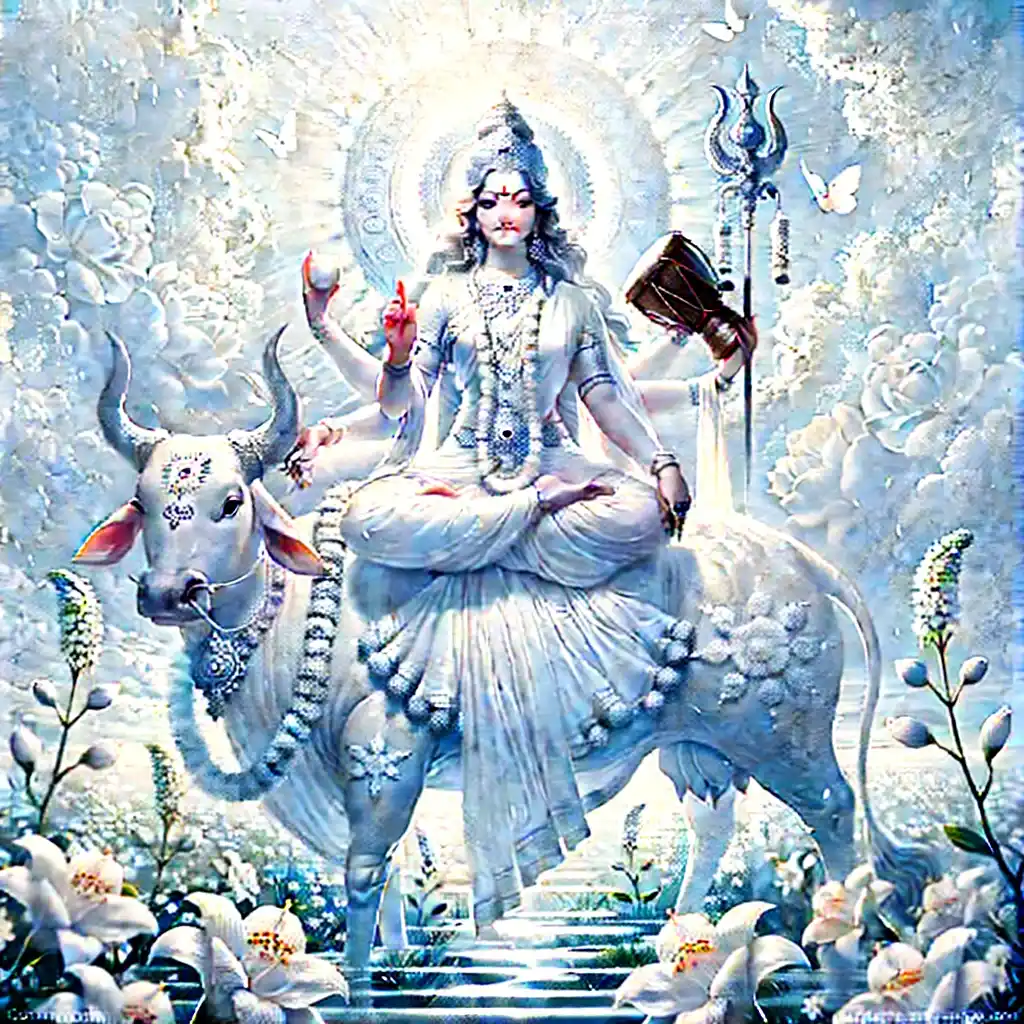
Explore the divine essence of Maa Mahagauri, the epitome of purity and tranquility in Hindu mythology. Learn about her transformative journey, significance during Navratri, and the rituals associated with her worship. Discover how she symbolizes inner peace and prosperity for her devotees.

Explore the latest and most popular products available on Amazon, handpicked for your convenience! Whether you're shopping for tech gadgets, home essentials, fashion items, or something special, simply click the button below to view the product on Amazon. We’ve partnered with Amazon through their affiliate program, which means that if you make a purchase through this link, we may earn a small commission at no extra cost to you. This helps support our site and allows us to continue providing valuable content. Thank you for your support, and happy shopping!
